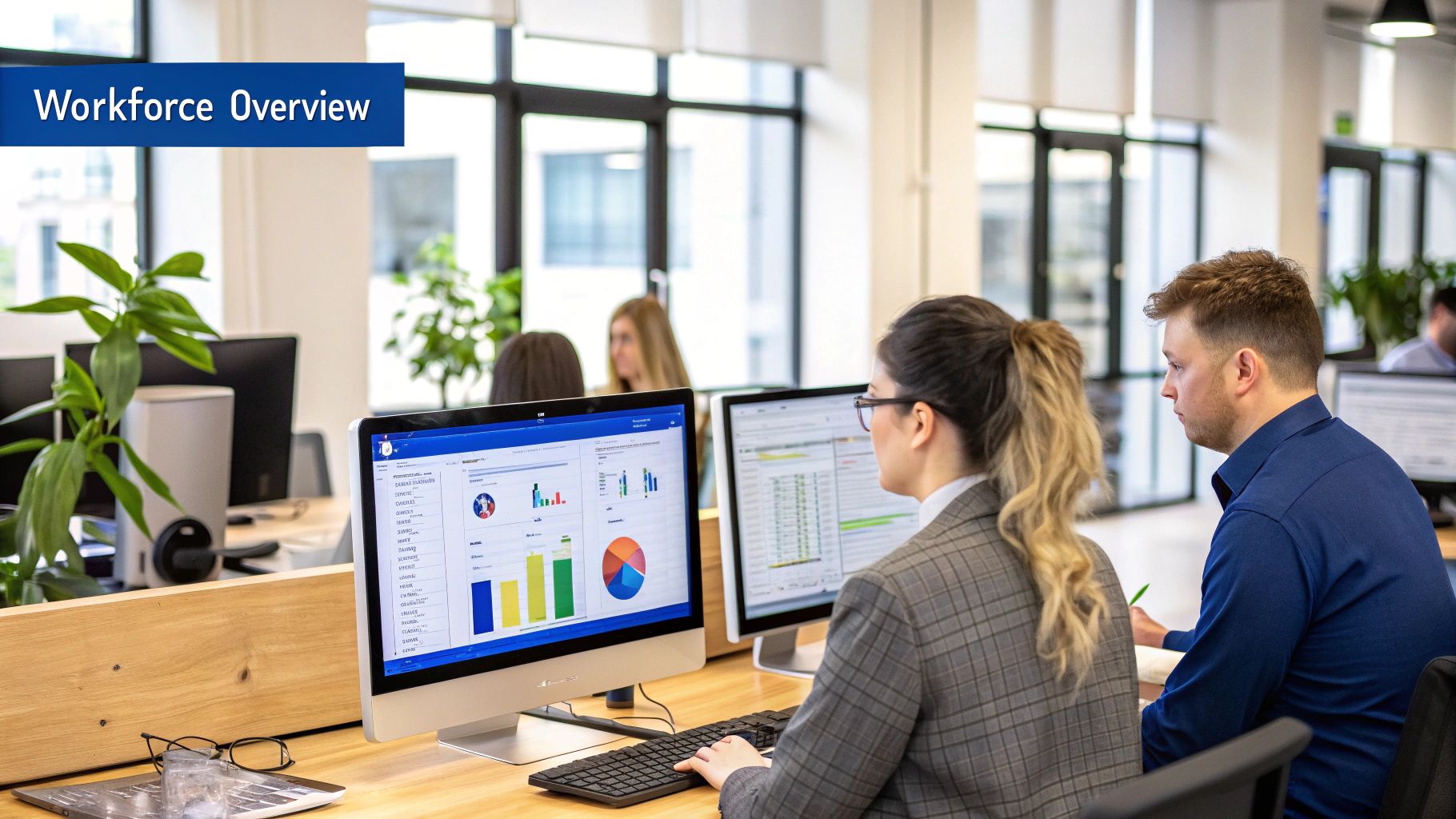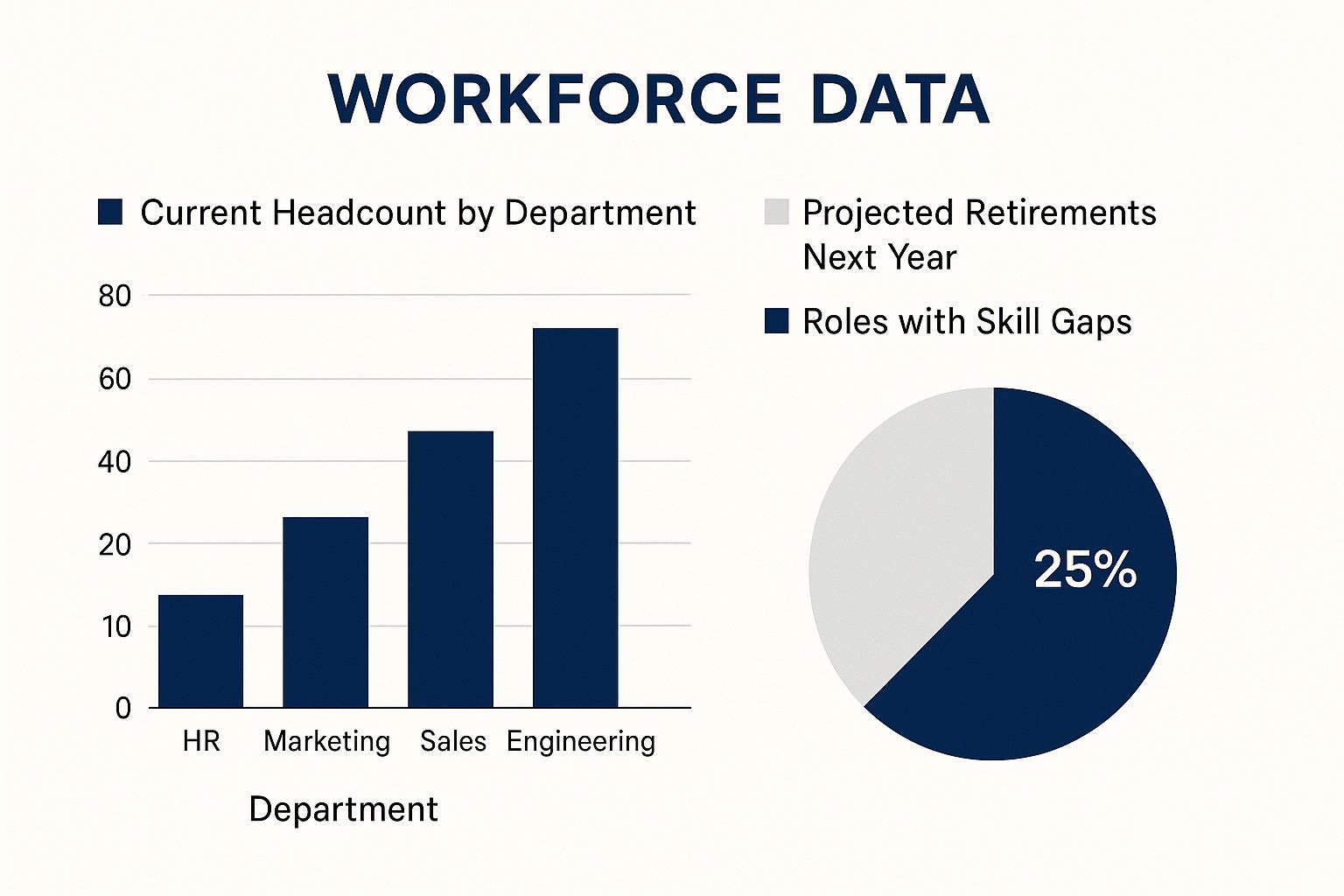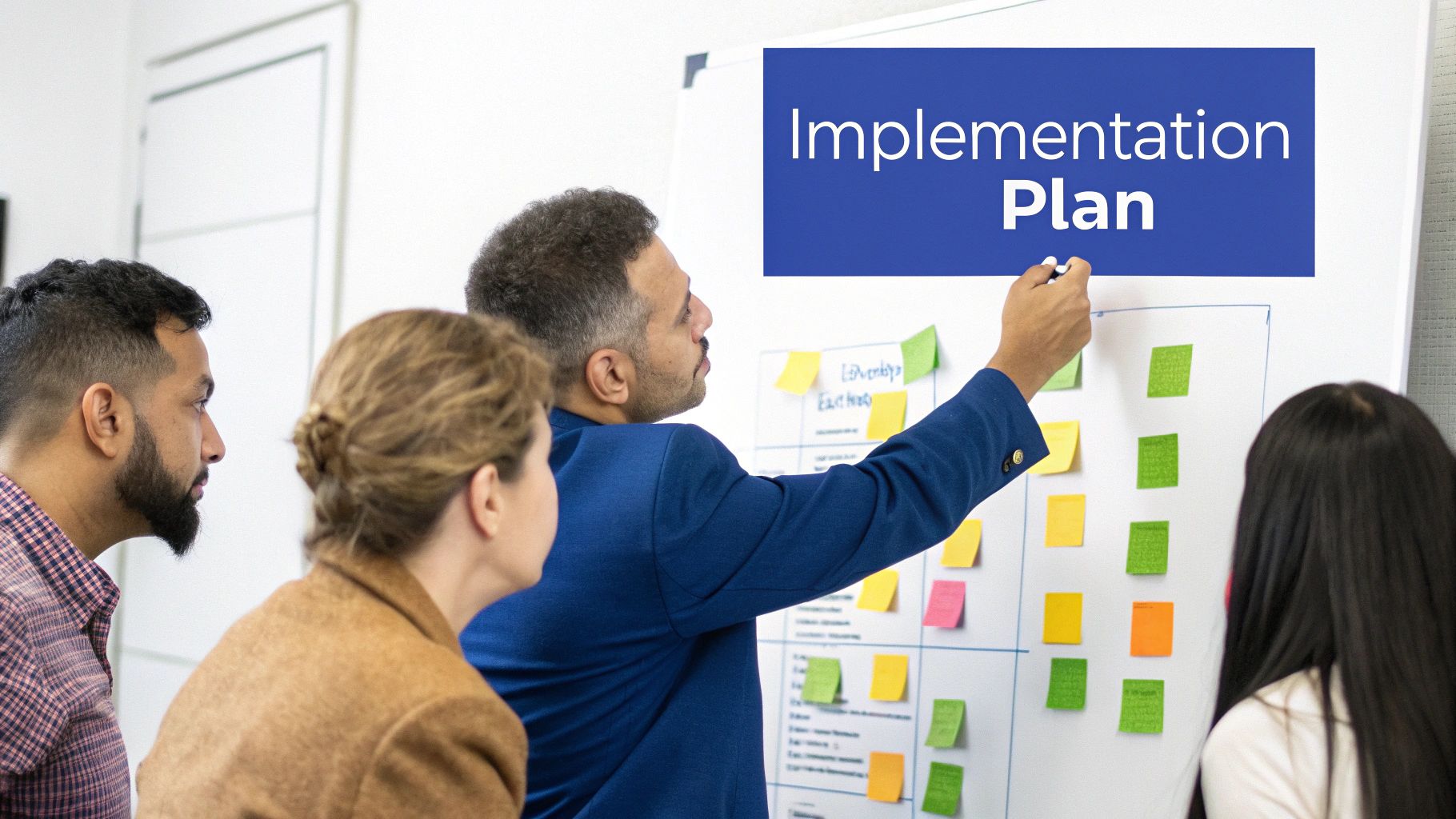At its heart, a workforce planning process is the strategic function of making sure you have the right people, with the right skills, ready to achieve your business goals. It’s a continuous cycle of analysing your current team, forecasting what you'll need in the future, and creating a solid plan to close any gaps through hiring, training, or even restructuring.
What Is Strategic Workforce Planning?

Let’s be clear: this goes far beyond simply tracking headcount. Strategic workforce planning is a critical business function, not just another HR task on the checklist. It's the essential bridge connecting your company's long-term vision to your talent strategy, building organisational resilience and turning your people into a genuine competitive edge.
Too many companies get stuck in a reactive hiring loop, only scrambling to fill a role after someone leaves. That’s an expensive and inefficient way to operate. A proactive workforce plan, on the other hand, lets you anticipate your needs, future-proof your organisation, and make deliberate, data-backed decisions about your talent pipeline.
Connecting People to Performance
The real goal here is to directly link your people to bottom-line growth. It forces you to answer the tough questions that will ultimately define your success:
- Do we have the leadership skills on board to guide the company through the next five years?
- What completely new roles will our digital transformation create, and where on earth will we find that talent?
- Is our team structured effectively to support our expansion into a new market?
By tackling these questions before they become crises, you move away from seeing talent as a cost centre and start treating it as a strategic investment. This mindset shift is fundamental to building a high-performing organisation. To explore these fundamentals further, our guide on human resource planning offers some great additional context.
A well-executed workforce plan doesn't just fill seats; it builds capabilities. It ensures that as your business strategy evolves, your workforce evolves right along with it, ready to meet new challenges head-on.
Why Reactive Hiring Fails
Relying on reactive hiring puts you in a constant state of fire-fighting. This often leads to rushed decisions, mismatched hires, and poor cultural fits. This approach is dangerously short-sighted. It completely misses the bigger picture, like a looming skills gap caused by a wave of retiring employees or a failure to develop your own people for future leadership roles.
Think about it. A tech company that suddenly realises it needs AI specialists will likely overpay in a fiercely competitive market because they're desperate. A more strategic approach would have identified this need a year earlier. That foresight would have given them time to launch an upskilling programme for their existing analysts or start building a targeted recruitment pipeline.
This forward-thinking is precisely what separates thriving companies from those that are always playing catch-up.
Forecasting Your Future Talent Needs
This is where the rubber really meets the road. It’s the point where you translate those ambitious company goals into a clear, actionable picture of the people you’ll need. We're not talking about pulling numbers out of thin air; this is about building a data-backed forecast of the skills your organisation will need in one, three, and even five years' time.
It’s about moving beyond a simple headcount. If your company is planning a major push into e-commerce, you don't just need "more staff". You need data scientists who can dig into customer behaviour, digital marketing gurus to get people to your website, and supply chain experts to handle the complex logistics. The first conversation should always be with your department heads to get a handle on their roadmaps and what they're trying to achieve.
Selecting the Right Forecasting Model
There's no single "best" way to forecast your talent needs. The right approach really depends on your specific situation—how stable your market is, how good your data is, and how complex your strategy is.
Here's a quick look at some common models I've seen work well in different contexts.
Workforce Forecasting Model Comparison
Choosing the right forecasting model is crucial. This table breaks down a few popular methods to help you decide which one aligns best with your company's data maturity, industry, and strategic direction.
Ultimately, the best model is the one that gives you the most reliable insights. Many organisations I've worked with actually blend these approaches, using trend analysis for some roles and scenario planning for more strategic, future-facing positions.
The chart below gives you a great visual snapshot of what this looks like in practice, breaking down a company's current workforce, expected retirements, and known skill gaps.

When you lay the data out like this, it becomes immediately obvious where your biggest risks lie. You can see at a glance which departments are about to be hit by retirements and where critical skill shortages are already a problem.
Integrating External Labour Market Data
Your internal data only tells half the story. A truly solid forecast requires a reality check from the outside world. You have to analyse what's happening in the broader labour market to understand if the talent you need will even be available and what the competition looks like.
A great forecast doesn't just predict what you need; it also assesses whether the talent you need will actually be available. Overlooking external market data is like planning a road trip without checking the weather forecast.
Just look at recent UK labour market data. The total number of workforce jobs climbed to 37.1 million in March 2025, yet the number of payrolled employees dipped in the following months. These kinds of fluctuations highlight why you can't just set your plan and forget it. For more detail, it's always worth diving into the latest UK labour market report.
This external context is what elevates workforce planning from an internal exercise to a truly strategic function. It's how you stay ahead of economic shifts instead of just reacting to them.
How to Conduct a Skills Gap Analysis

Once you’ve got a handle on your future talent needs, it’s time to look inwards. This next stage is all about understanding the skills and potential you already have on the payroll. This isn't just a simple headcount. It’s a proper deep-dive into the capabilities sitting within your current team, which is where a skills gap analysis comes in. Think of it as measuring the distance between where your team’s skills are today and where they need to be tomorrow.
This analysis gives you an honest, clear baseline. It shines a light on critical shortages, flags any potential redundancies, and, most importantly, shows you where you can upskill your own people. It’s the evidence you need to make those tough "build versus buy" talent decisions with confidence.
Inventorying Your Current Skills
Your first task is to build a complete inventory of the skills you currently have in-house. This means cataloguing the real-world capabilities of your employees, looking far beyond official job titles and qualifications. You need to get a true picture of what your people can actually do.
I've found a few practical methods work really well for gathering this intel:
- Self-Assessments: Give employees a chance to rate their own skills against a clear competency framework. You’d be surprised what hidden talents people have that they don't get to use in their daily tasks.
- Manager Evaluations: Line managers see their teams in action every day. Their perspective is absolutely vital for backing up self-assessments and adding a layer of objectivity.
- Performance Data: Dig into recent performance reviews. They're a goldmine of information about individual strengths and areas that need development. Keep an eye out for patterns that emerge across different teams.
- Skills Assessments: For those really crucial technical roles, you can’t beat formal testing or certifications. They provide solid, undeniable proof of someone's proficiency.
Remember to capture both hard skills (like knowing a specific software or data analysis) and soft skills (like communication or creative problem-solving). Both are essential for a well-rounded and successful organisation.
Identifying the Gaps and Risks
With your skills inventory in hand, you can now hold it up against the future needs you forecasted earlier. This is the moment of truth where the gaps really start to show. For instance, you might find you’re flush with project coordinators but desperately short on data scientists.
But don't just stop at skill shortages. You also need to dig into demographic data to spot potential risks lurking beneath the surface. I’ve seen companies map out employee tenure and age, only to realise that a huge chunk of their institutional knowledge is held by a group of people approaching retirement. Losing all that experience at once could be a massive blow.
A proper skills gap analysis does more than just find what's missing. It helps you see around corners, predicting future talent risks before they become business-critical problems.
This whole process is also shaped by what's happening in the wider market. For example, between February and April 2025, the UK's working-age employment rate was 75.1%, yet unemployment figures also climbed. This apparent contradiction points to a mismatch between the skills available out there and what businesses actually need. This makes understanding your internal talent pool even more critical. You can read more about these complex labour market dynamics from the Institute for Employment Studies.
Pulling all this information together gives you a clear map. It tells you exactly where your workforce planning needs to focus—whether that’s on highly targeted recruitment, new internal training programmes, or even a bit of strategic restructuring.
Building Your Workforce Action Plan
https://www.youtube.com/embed/AGQyaGtrTUc
Right, you’ve done the heavy lifting of forecasting and analysing your skills gaps. Now for the exciting part: turning all that insight into a concrete action plan. This is where the rubber really meets the road, transforming your analysis into a clear roadmap that will guide your entire talent strategy.
Let’s be realistic—there's rarely a single silver bullet. A truly effective action plan is almost always a blend of different tactics. You'll need to decide on the best mix of recruiting fresh faces, developing your current team, or even bringing in temporary experts. Each path has its pros and cons, and the right combination depends entirely on the specific talent gaps you need to fill.
Choosing Your Strategy: Build, Buy, or Borrow?
When it comes to closing those talent gaps, your action plan will revolve around three core strategies. I've found that a balanced approach, mixing immediate fixes with long-term capability building, delivers the best results.
Build (Internal Training): This is all about upskilling or reskilling the people you already have. It's a fantastic move for morale and retention because it shows you're genuinely invested in your team's growth. The catch? It takes time. You can't turn a novice into a seasoned expert overnight.
Buy (Recruitment): The classic approach—hiring new talent from the outside. This is often the quickest way to get your hands on specific, hard-to-find skills. The downside is that it can get expensive, and there's always the risk that a new hire might not be the right cultural fit, no matter how good they look on paper.
Borrow (Contractors or Consultants): Tapping into freelancers, contractors, or consulting firms gives you incredible flexibility. This is perfect for short-term projects or when you need highly specialised knowledge without the long-term commitment and overheads of a full-time employee.
Imagine your analysis highlights a critical need for AI specialists. A smart action plan might tackle this from all three angles. You could launch a highly targeted hiring campaign (buy), create an internal upskilling programme for your current data analysts (build), and bring in a specialist consultant to guide the initial project stages and get things moving quickly (borrow).
Prioritising Initiatives and Assigning Ownership
You can't do everything at once. The next step is to look at your list of initiatives and prioritise them based on urgency and business impact. A looming wave of retirements in a mission-critical department, for example, is obviously a much higher priority than a minor skills gap in a less vital area.
The best action plans I’ve ever seen don't just list what needs to be done. They assign clear ownership and deadlines. An initiative without an owner is just an idea; an initiative with an owner is a project.
Once you've set your priorities, every single action needs a designated owner and measurable Key Performance Indicators (KPIs). For a recruitment drive, your KPIs might be time-to-fill and cost-per-hire. For a new training programme, you could track things like completion rates and measure the performance improvements that follow. This accountability is what separates plans that succeed from those that just gather dust.
This isn't just good practice; it's a cornerstone of effective talent management. Research from industrial-organisational psychology shows that assigning clear executive accountability is fundamental. When organisations systematically develop their high-potential employees, they often see a measurable rise in revenue growth per employee. You can read more about how structured talent development impacts business performance from the Society for Industrial and Organizational Psychology.
Finally, any successful plan eventually leads to new hires, and you have to set them up for success. Make sure your action plan links directly to a well-structured onboarding process. For more on getting this right, check out our guide on employee onboarding best practices. A great onboarding experience ensures your new talent integrates smoothly and starts adding real value from day one.
How to Measure and Refine Your Plan

Here’s a common mistake I see all the time: a company spends months creating a detailed workforce plan, only to let it gather dust in a folder. A workforce plan isn't a static document you create once and forget about. The best organisations treat it as a living strategy, something that needs to be constantly measured and tweaked.
This continuous cycle of improvement is what keeps your workforce agile and locked in with where the business is headed. Think about it—market conditions can change on a dime, new priorities pop up, and unexpected challenges are always around the corner. If you’re not regularly checking in on your plan, it can become irrelevant almost overnight. The trick is to build that rhythm of review and refinement right into the process from the start.
Establishing a Regular Review Cadence
To keep your plan relevant and effective, you absolutely must set up a regular schedule for reviewing it. I often recommend treating it like a quarterly business review (QBR), but with a laser focus on your people strategy. These meetings are your dedicated time to look at the hard data and honestly assess what's working and what isn't.
In these reviews, you’ll be holding up your progress against the KPIs you initially set. Are we hitting our hiring targets for those critical tech roles? Are the new leadership training programmes actually producing better managers? Catching small deviations early, during these regular check-ins, prevents them from snowballing into major headaches down the line. It transforms your workforce plan from a one-off project into a dynamic part of your operational heartbeat.
A workforce plan is a compass, not a map. It sets your direction, but you must constantly check your position and adjust your course based on the changing terrain and conditions you encounter.
Key Metrics to Track
The metrics you track are everything; they're the vital signs that tell you if your plan is healthy. While your specific KPIs will depend on your unique goals, there are a few core metrics that I believe are non-negotiable for almost any business.
Time-to-Fill: Seriously, how long is it really taking to fill those crucial open positions? A consistently long time-to-fill can be a symptom of a weak recruitment strategy or maybe just unrealistic expectations about the current talent pool.
Cost-per-Hire: What’s the all-in investment to get a new employee through the door and up to speed? Tracking this helps you keep a tight rein on your recruitment budget and shows the tangible financial value of your efforts.
Retention Rate of Key Talent: This one is huge. Are you holding onto the people who are absolutely critical to your business's success? High turnover in these roles is a massive red flag that something is wrong. Knowing how to reduce employee turnover is a make-or-break skill for anyone involved in people strategy.
Internal Mobility Rate: How many of your people are moving into new roles within the company? A healthy internal mobility rate is proof that your development programmes are hitting the mark and that your team sees a real future with you.
ROI of Training Programmes: Are those upskilling initiatives actually delivering? You can measure this by looking at performance improvements after training or by tracking how many employees successfully move into new roles that require those skills.
Got Questions About Workforce Planning? We've Got Answers.
It's only natural to have questions when you're getting to grips with a new business process, and workforce planning is certainly no exception. To help clear things up, I’ve put together answers to some of the most common queries I hear from business leaders.
Think of this as a quick-start guide to troubleshoot common sticking points and apply these powerful ideas in your own company.
How Often Should We Update Our Workforce Plan?
Your main strategic workforce plan should get a full review and refresh every year, ideally timed to coincide with your annual business planning and budgeting cycle. This keeps your talent strategy perfectly aligned with your company's big-picture goals for the upcoming year.
But don't make the mistake of filing it away for 12 months. The best companies I've worked with treat their plan as a living, breathing guide.
A workforce plan isn't a static report to be shelved; it's a dynamic roadmap. You should be checking your key metrics and making smaller, tactical adjustments at least quarterly. This agility is what allows you to react smartly to market shifts, unexpected staff turnover, or a sudden pivot in business priorities.
What's The Biggest Mistake Companies Make?
Without a doubt, the most common trap is treating workforce planning as a standalone HR task that’s all about counting heads. This narrow perspective completely misses the point and cripples the plan’s potential right from the start.
When it works, strategic workforce planning is a core business function. That means you need active participation and buy-in from leaders right across the business. If you don't have finance, operations, and marketing in the room, your plan will be built in a vacuum, lacking the real-world context needed to achieve anything meaningful. It ends up being a theoretical exercise instead of a practical tool for growth.
Can Small Businesses Really Benefit From This?
Absolutely. The scale might be different, but the fundamental principles of matching your people to your goals are just as crucial for a small business—arguably even more so. For a smaller team, every single hire carries enormous weight.
For a small business, a simplified workforce planning process could look like this:
- Pinpoint the one or two most critical roles you need to drive growth in the next 12-18 months.
- Assess if the skills you need for those roles already exist somewhere in your current team.
- Map out a simple, focused plan to either upskill an existing employee or kick off a highly targeted recruitment search.
This kind of thinking forces small businesses to be proactive, not reactive, with their most important asset: their people. It makes sure every new person who joins the team is a deliberate step towards achieving the company's vision.

